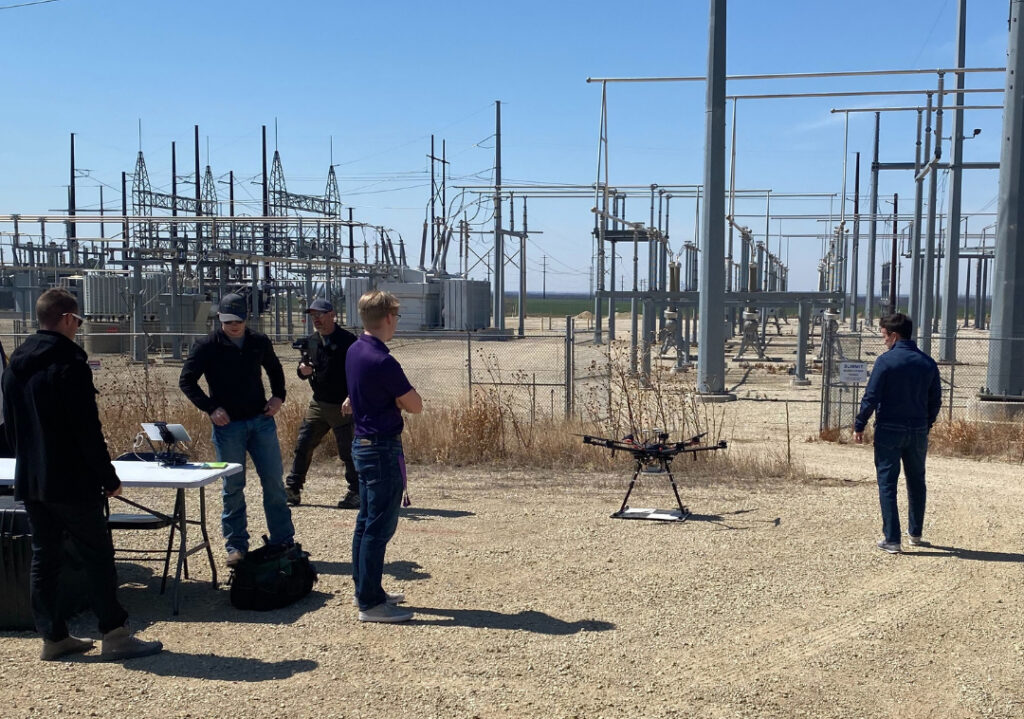K-State Salina UAS students gain real-world experience in project involving industry partners
Students in the unmanned aircraft systems program at Kansas State University Salina Aerospace and Technology Campus gained valuable industry experience and practice using the latest drone technology on an ongoing project with two of the university’s commercial enterprise partners.
The project involved four K-State Salina students: two UAS design and integration majors and two in the UAS flight and operations degree option. The industry partners were Evergy and a Light Detection and Ranging, or LiDAR, sensor manufacturer.
A LiDAR sensor shoots out millions of lasers to pinpoint different spots and objects on the ground. The spots then reflect back up to the sensor, which provides the operator with data. The sensor can be put on a drone to create a 3D visualization of the terrain that the drone flies over, accurately depicting the distance between objects down to centimeters.
This sensor is relatively new to the field of unmanned aircraft and Evergy is considering its use as a way to inspect substations and power lines for possible repairs or to detect other problems.
When the sensor manufacturer offered an opportunity for faculty and students at K-State’s Applied Aviation Research Center to familiarize themselves with the capabilities of the new sensor, Kurt Carraway, UAS department head, asked about the manufacturer’s interest in supporting an interdisciplinary undergraduate research project. Next, Carraway approached Mike Kelly, Evergy Energy’s senior UAS coordinator, to see if the utility would also be willing to sponsor the project. With the project sponsorship aligned, Carraway coordinated with Raju Dandu, the UAS senior design and integration instructor, to set up the student project.
“We are fortunate to have two of our corporate partners and industry leaders bring this opportunity to our undergraduate students,” Carraway said. “This experience helps prepare our students to enter into this high-tech industry.”
The K-State Salina students gained firsthand experience using a LiDAR sensor, which was donated by the sensor manufacturer, and recorded their findings from the project to give to Evergy. The utility company will use the data to decide whether the technology fits its needs. The students also provided feedback to the sensor manufacturer about their experiences using the LiDAR sensor on UAS.
Noah Endreshak, a senior in UAS flight and integration, Salina, was one of the students involved in the project. Endreshak said it was a one-of-a-kind experience for him and the other students involved.
“K-State Salina’s students have never used a LiDAR sensor on any of our drones before, so there was a bit of a learning curve,” Endreshak said. “This was a great opportunity to get this experience in school because no other collegiate UAS program uses this technology. Thanks to the sponsorship of our program between the two companies, we were able to learn new skills that we otherwise wouldn’t have had the opportunity to do so.”
The LiDAR sensor can be used to gather data such as shifts in the ground, topography changes to the elevation, water runoff or damage to a substation or power line.
“Partnering with K-State and LIDAR provided an excellent opportunity for students to receive experience using the latest in drone technology,” Kelly said. “Evergy was extremely excited to be asked to participate in this first-ever demonstration between a university, utility and sensor manufacturer.”
UAS students flew the drone equipped with LiDAR over the Evergy Summit substation on Feb. 25 and then over a series of power lines going to the same substation on March 28.
Endreshak said that this project was more than just a school assignment; it was an opportunity for the students to showcase their talents and their abilities to two of the university’s industry partners and could potentially lead to greater opportunities down the road with the skills that they gained.
“This experience was so valuable to us as students,” Endreshak said. “It’s very nice to work with industry people and get that real-world experience because that’s what this university is all about. Not only is it hands-on work with the new system and sensor, but it also serves as a great introduction to the real-world field with a company that has a huge footprint in the Midwest. If you make a good first impression and provide good data, then there’s a chance that we could get a job lined up with a potential employer.”
K-State News and Communications Services
Division of Communications and Marketing
128 Dole Hall
1525 Mid-Campus Drive
Kansas State University
Manhattan, KS 66506
785-532-2535
media@k-state.edu
k-state.edu/media

